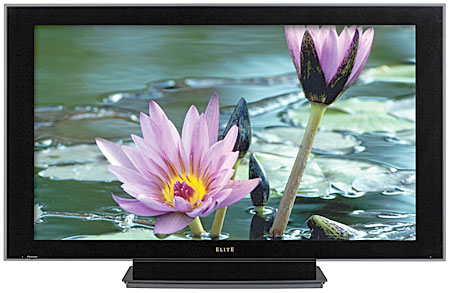Pioneer Elite PRO-FHD1 Plasma HDTV Monitor

Price: $8,000
Technology: Plasma Display Panel
Resolution: 1920x1080
Size: 50"
Inputs: 2 x HDMI (HDCP), DVI-D (HDCP), composite, S-Video
Highlights: Pure Vision II video processing, ISFccc calibration, Deep Encased Cell Structure panel for better focus, First Surface Pure Color Filter for improved colors, Crystal Emissive Layer for improved brightness and contrast.
Love at first sight can be fickle, and fleeting. That's why it's a little scary to write a sneak peak of a product under review so early in the review process. But Pioneer Elite's 50" PRO-FHD1 is the first production full 1080p plasma on the market, and I'm so enthusiastic about what I'm seeing so far that a progress report is warranted. And yeah, something might come up later to break the spell, but so far this plasma has me mesmerized.
Before I give up the goods, some particulars. First, when we last wrote up this plasma as a "First Look" component it was a full ten grand. Not any more. It's still expensive at $8K, but hey, that's still a couple thousand bucks in your pocket you can spend on, oh, I don't know, some 1080p sources to plug into this sucker.
As you can see from the above, Pioneer is marketing this plasma with a lot of technical gobbledygook about why it looks good. I can't verify or comment on the cell structures, emissive layers (can Tums cure that?) or any of that. In fact, I think Pioneer might have hired someone who writes the engineering room technobabble for one of the Star Trek series to come up with some it. But I can tell you the picture kicks ass, so whatever it means, there might be something to it.
Of note is that unlike the Pioneer Elite plasmas of the past (even the far less expensive ones), the PRO-FHD1 does not ship with the separate media receiver to which source components are connected. This plasma is well outfitted with ins and outs, including dual HDMI inputs, but lacks the convenience of connecting sources to the receiver, and then tethering that to the TV via a simple umbilical set of cables that don't change even when your sources do. The separate media receiver is great for in-wall or on-wall installations for that reason, and you're right for thinking $8K should be enough buy you that added convenience.
The Pioneer is also strictly a video monitor. That is, it has neither a high nor standard definition over-the-air tuner, so must be used with an outboard set-top box for any sort of broadcast, satellite, or cable programming.
Of course, what I'm really here to do is talk about how the first 1080p plasma looks, and in a word it's awesome. First off, I've verified with my Accupel generator that this 1080p plasma can do full justice to the single-pixel width burst with 1080i at the full 37.1Mhz limit. There's a smidge of banding in the burst, but clear, strong resolution at the limits of my test signal generator. Only Marantz's VP-11S1 1080p DLP projector has matched this performance. In other words, this is full-on 1080 HD! As you can imagine, this means that the imagery is sharp as a tack, especially the best HD broadcasts. The black-sand contrast, coupled with this mind boggling resolution make for that rarified, three-dimensional "looking through a window" level of resolution whenever the source material is up to it.
But crispness and dimensionality are hardly all the PRO-FHD1 has going for it. The image is very, very natural and un-digital. It never looks digitally "painted" as some flat panels do, and the image is shockingly and consistently free of noise, posterization and false contouring in a way that no other flat panel I've seen can lay claim to. It simply looks pure and clean and sharp as a tack when the material is such. And even when it's not the Pioneer has tools to clean things up without messing things up- its noise reduction (NR) circuits help and do very little harm up to the Mid settings.
The grayscale dialed in nearly perfectly in record time. Colors are mostly natural if a little warm on flesh tones, reminding me of the RT-based Elite RPTVs of yesteryear. But I was most impressed with greens, which look deep and natural, not limey or nuclear. Watching different baseball and football games in HD on different networks I could see clear differences in the color of the various fields and turfs without the TV imposing its own cast on the fields. Color reproduction overall reminds me of the better front projection rigs I've seen- accurate, but also natural and pleasing to the eye.
The other bugaboo of the flat panel, and digital displays in general are the blacks, or perhaps more accurately, grays where there should be blacks. The Pioneer is unexcelled in my experiences with flat panels of any technology. The blacks are deeper, but even during torturously dark scenes the FHD1 does two things that separate it from the other sets I've seen. The first is that although the image does appear more charcoal gray than black in the very darkest movie scenes, there is still some semblance of contrast. And two, the other artifacts that so often accompany weak blacks in digital displays were notably absent.
There was no posterization or excessive noise of the sort that often appear on other displays in which the dark areas become alive with movement and splotches of color. It just fades to a charcoal, and even in the worst of scenes it's still remarkably watchable and strikingly clean and devoid of other artifacts.
All this being said, I've just begun to dig into this set. Maybe I'll find some warts and eat some of these words. You'll have to read the full review here at UAV in a few weeks to get the whole scoop. But for now, it's love at first sight.








































